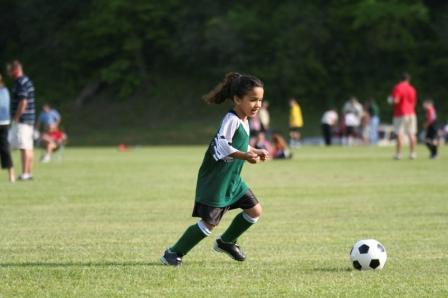Back-to-School Soccer Season
Prime time for foot and ankle injuries.
Parents and coaches should think twice before coaxing young, injury-prone soccer players to "play through" foot and ankle pain, according to the American College of Foot and Ankle Surgeons.
"Skeletally immature kids, starting and stopping and moving side to side on cleats that are little more than moccasins with spikes—that’s a recipe for foot and ankle sprains and worse," cautions Christopher Hendrix, DPM, FACFAS, a Memphis, Tennessee foot and ankle surgeon.
"Kids will play with lingering, nagging heel pain that, upon testing, turns out to be a stress fracture that neither they, their parents nor their coaches were aware of," he said. "By playing with pain, they can’t give their team 100 percent and can make their injuries worse, which prolongs their time out of soccer."
Hendrix said he has actually needed to show parents x-rays of fractures before they will take their kids out of the game. "And stress fractures can be subtle—they don’t always show up on initial x-rays."
Stress Fractures, Achilles Tendonitis, Heel Pain, Ankle Sprains, Broken Toes
Symptoms of stress fractures include pain during normal activity and when touching the area and swelling without bruising. Treatment usually involves rest and sometimes casting. Some stress fractures heal poorly and often require surgery, such as a break in the elongated bone near the little toe, known as a Jones fracture.
Constant running in socer can place excessive stress on the foot. Pain from overuse usually stems from inflammation, such as around the growth plate of the heel bone, more so than a stress fracture, according to Hendrix.
"Their growth plates are still open, and bones are still growing and maturing—until they’re about 13 to 16. Rest and, in some cases, immobilization of the foot should relieve that inflammation," he said.
Hendrix added that Achilles tendonitis and plantar fasciitis (heel pain caused by inflammation of the tissue extending from the heel to the toes) are other types of overuse injuries.
Quick, out-of-nowhere ankle sprains are also common in soccer.
"Ankle sprains should be evaluated by a foot and ankle surgeon to assess the extent of the injury," said Hendrix. "If the ankle stays swollen for days and is painful to walk on or even stand on, it could be a fracture," Hendrix said.
Collisions between soccer players take their toll on toes.
"When two feet are coming at the ball simultaneously, that ball turns into a cement block and goes nowhere. The weakest point in that transaction is usually a foot, with broken toes the outcome," he explained. "The toes swell up so much the player can't get a shoe on, which is a good sign for young athletes and their parents. If they are having trouble just getting a shoe on, they shouldn't play."
Treat Injuries Immediately
If you think your child has suffered any sort of foot or ankle soccer injury, consult a foot and ankle surgeon right away.